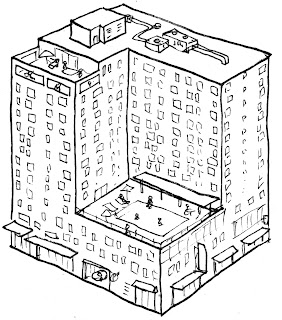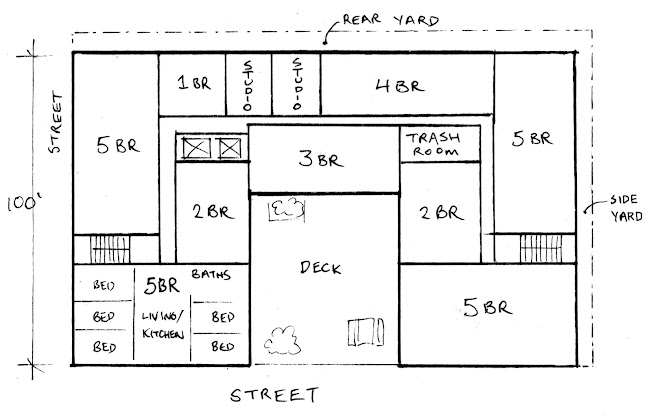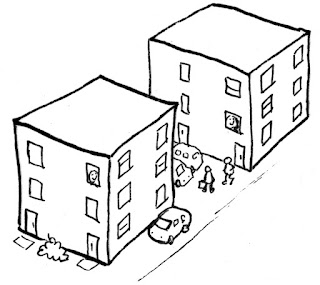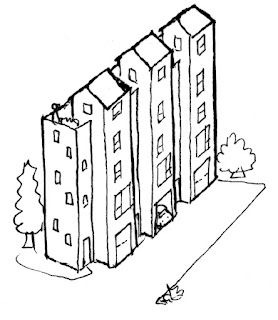Student Apartment Tower
Time period: 21st century
Location: Within walking distance of a flagship state university
Large apartments designed to be shared by roommates, plus amenities and retail.
If you live in a college town, chances are you've seen a number of large apartment towers pop up on the skyline just outside campus. These massive buildings, the largest of which house over 1,000 students, might be called "luxury student housing" or "student containment blocks" depending on who you ask. They are the result of a number of trends that started as far back as the 1970s and have converged today.
Enrollment Trends at Public Universities
In the USA, most colleges are funded by state governments, a legacy of the 1862 Morrill Act, which created land grant public universities. Back then, the federal government had a smaller role than today, so it made sense for colleges to be run at the state level.
In the 1970s, several years of inflation after the oil shock provided the popular support for anti-tax interests to carry out their agenda, making major cuts to government revenue. Since state and local governments must balance their budget and cannot print money or do deficit spending, this meant that state spending on colleges got cut back. The war on drugs led to a huge increase in the number of people sent to prison, using up even more state dollars. Like education, incarceration is also mostly handled at the state level in the USA.
For a while, it was manageable. By the 1970s, most Baby Boomers were past college-attending age. The following generation, Gen X, was much smaller in size, and for the next 20 years, the number of people turning 18 each year went down, even as the country's total population grew.
However, by the mid 1990s, Millennials - the children of the Baby Boomers - were reaching college age. In California, planning called it "Tidal Wave II" and expected a 43% increase in enrollment, peaking around 2010 as the last few years of Millennials graduated high school. In reality, other factors caused the wave to be more like sea level rise, continuing well past 2010 with no sign of slowing down.
As predicted, the total number of students in college peaked in 2010. However, four-year public universities kept growing past their 2010 peaks. Since more jobs asked for a 4-year college degree, more students chose 4-year colleges rather than 2-year community college. Also, fewer people went to for-profit colleges and private colleges. Instead, they chose public colleges, which offer better value.
The Amenities Arms Race
Let's go back to the funding crisis. In the 1990s, public colleges received less funding per student than they did in the 1970s. However, state governments were under pressure from parents to admit more students, especially to the flagship public universities that are popular with the middle class. Fortunately, the best way to a balanced budget was to increase enrollment, rather than cut back. There were a couple reasons for this. First, colleges have a lot of fixed costs, such as the sports teams. As long as there was still space in the lecture hall (and with webcast classes, even if there wasn't space), adding another student gets more money coming in but doesn't cost the school anything extra.
Second, rising wealth in other parts of the world, especially Asia, created what appeared to be a bottomless supply of international students who paid full tuition. By enrolling more international and out-of-state students, a college could make a profit, that could then be used to subsidize more in-state students.
The best colleges could compete for these top-dollar students on the prestige of their name alone. The average school joined the amenity arms race, where colleges built resort-style amenities such as spas, fine dining, climbing gyms, and even lazy rivers. Colleges were criticized for spending on amenities at a time when tuition was already going up. In a mirror to the rising amounts of student debt, many colleges had taken on a lot of debt to build amenities, and were reaching their borrowing limits.
The demand for student housing remained though. As colleges enrolled more students without building more dorms, college towns faced housing shortages and rising rents. This is where the private sector stepped in. First, there were public-private-partnerships, where a corporation would build student housing, and then lease the whole building to a college, which would then lease individual rooms to students. Many companies also leased directly to students.
Large Shared Apartments
In most 21st century privately built apartments, the majority of units are studios and one bedrooms, since the greatest demand is from people living alone. For student apartments, the reverse is true - most apartments have lots of bedrooms, with 3, 4 and 5 bedroom apartments being common. This takes advantage of zoning laws that limit the density, or charge development fees by unit, which means a studio counts the same as a 5-bedroom. In places where zoning has requirements based on the number of bedrooms, the bedroom county might be lower, but with larger rooms designed for 2 or 3 beds.
There are still a few studios and 1-bedroom apartments in the mix. Friend groups come in all sizes, incomes, and preferences. Building owners want to have a variety of units so that no matter how many are in a group, they can mix and match to get the right number of bedrooms.
Why apartments instead of private dorms? In many places, dorms are zoned as group living and is either not permitted or subject to many restrictions, while apartments are legal to build. In addition to feeling less institutional, apartment-style student housing has operational advantages as well. Maintenance costs are lower, since residents clean their own bathrooms, instead of having staff clean shared bathrooms.
In case other investors or the college itself builds more housing and creates an oversupply, apartment-style buildings are also easier to adapt to renting to the general population. This is more common in downtown areas and near transit, where the building could eventually be where students want to keep living after graduation. Buildings built with this in mind will have smaller units, such as 2-bedroom apartments.
Since being close to campus is the biggest amenity of all, land is expensive, and these buildings are very high density. US college towns are infamous for NIMBYs and restrictive zoning, but many have grudgingly allowed a couple neighborhoods near campus to be a student containment zone, realizing the alternative to allowing new apartments is houses in single-family zoned neighborhoods turning into rentals for large groups of students (the dreaded mini-dorm).
Example of a typical residential floor of a student apartment tower. Note that rear facing apartments often face a tiny yard. Most students won't pay extra for a view.
Since the start of COVID, many office jobs remain fully or partially remote, but colleges returned to in-person classes starting in the 2021-2022 school year. This means that while the market for downtown apartments near office jobs remains weak, the student housing market is stronger than ever, soaking up investment dollars and construction labor that was previously building highrise downtown apartments.
Data
- Density: 100-300+ units/acre (note that average unit is larger than most apartments)
- Typical Lot Size: 1/2 acre or larger
- Typical Zoning: High Density Residential, Commercial Mixed Use
- Construction Type: Concrete
- Resident Type: Rental, rented by the room
Where to build
- As close as possible to major state universities
- In student neighborhood near retail
Further Reading
California tax revolt https://calmatters.org/politics/2020/10/prop-13-family-tree/
Growth in California prison spending vs education spending. https://www.huffpost.com/entry/california-prisons-schools_n_3839190
High school graduates by year https://nces.ed.gov/programs/digest/d17/tables/dt17_219.10.asp
Tidal Wave II planning in 2000 https://ucnet.universityofcalifornia.edu/retirees/new-dimensions/pdf/nd_15_1.pdf
Actual UC enrollment https://www.universityofcalifornia.edu/about-us/information-center/historical-enrollment
Enrollment at public flagship universities https://www.urban.org/sites/default/files/2022-10/Trends%20in%20Enrollment%20Growth%20at%20Public%20Flagship%20Universities.pdf
Nationwide enrollment https://educationdata.org/college-enrollment-statistics
Decline in higher education funding https://www.pewtrusts.org/en/research-and-analysis/issue-briefs/2019/10/two-decades-of-change-in-federal-and-state-higher-education-funding
International enrollment https://www.insidehighered.com/admissions/article/2021/11/15/international-students-increase-following-pandemic-declines
Student housing preference survey from 2010 https://files.eric.ed.gov/fulltext/EJ1072668.pdf
Student housing arms race https://files.eric.ed.gov/fulltext/EJ1255471.pdf
More on the student housing arms race https://fountainresidential.com/a-history-of-the-arms-race-in-student-housing-brent-little-interview/
The limits of the amenity arms race https://www.forbes.com/sites/michaeltnietzel/2018/11/05/students-begin-to-tap-the-brakes-on-the-campus-amenities-arms-race/?sh=2476801f1bcc
Growth in student debt https://educationdata.org/student-loan-debt-statistics
Growth in borrowing for non-tuition expenses such as rent https://www.nasfaa.org/news-item/16093/Report_Most_Borrowers_Take_Out_Student_Loans_for_Non-Tuition_Expenses
Investment trends in student housing https://www.naiop.org/research-and-publications/magazine/2017/spring-2017/finance/why-investors-are-flocking-to-student-housing/
Current trends in student housing https://www.multihousingnews.com/what-experts-expect-for-student-housing-in-2023/






Comments
Post a Comment